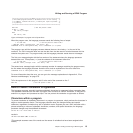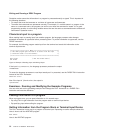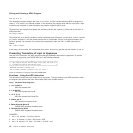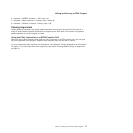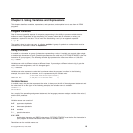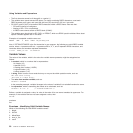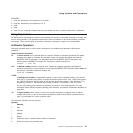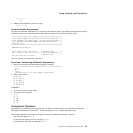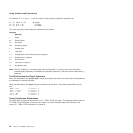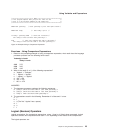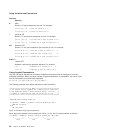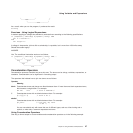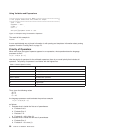
ANSWERS
1. Incorrect, because the first character is a number.
2. Incorrect, because the first character is a “£”.
3. Valid
4. Valid
5. Valid, but it is a special variable name that you should use only to receive results from a subroutine.
Using Expressions
An expression is something that needs to be evaluated and consists of numbers, variables, or strings, and
zero or more operators. The operators determine the kind of evaluation to do on the numbers, variables,
and strings. There are four types of operators: arithmetic, comparison, logical, and concatenation.
Arithmetic Operators
Arithmetic operators work on valid numeric constants or on variables that represent valid numeric
constants.
Types of Numeric Constants
12 A whole number has no decimal point or commas. Results of arithmetic operations with whole
numbers can contain a maximum of nine digits unless you override this default by using the
NUMERIC DIGITS instruction. For information about the NUMERIC DIGITS instruction, see
section section “NUMERIC” on page 150. Examples of whole numbers are:
123456789 0 91221 999
12.5 A decimal number includes a decimal point. Results of arithmetic operations with decimal
numbers are limited to a total maximum of nine digits (NUMERIC DIGITS default) before and after
the decimal. Examples of decimal numbers are:
123456.789 0.888888888
1.25E2
A floating point number in exponential notation, is said to be in scientific notation. The number
after the "E" represents the number of places the decimal point moves. Thus 1.25E2 (also written
as 1.25E+2) moves the decimal point to the right two places and results in 125. When an "E" is
followed by a minus (-), the decimal point moves to the left. For example, 1.25E-2 is .0125.
You can use floating point numbers to represent very large or very small numbers. For more
information about scientific notation (floating point numbers), see section “Exponential Notation” on
page 222.
-12 A signed number with a minus (-) next to the number represents a negative value. A signed
number with a plus (+) next to the number represents a positive value. When a number has no
sign, it is processed as if it has a positive value.
The arithmetic operators you can use are:
Operator
Meaning
+ Add
− Subtract
* Multiply
/ Divide
% Divide and return a whole number without a remainder
// Divide and return the remainder only
Using Variables and Expressions
Chapter 3. Using Variables and Expressions 21



